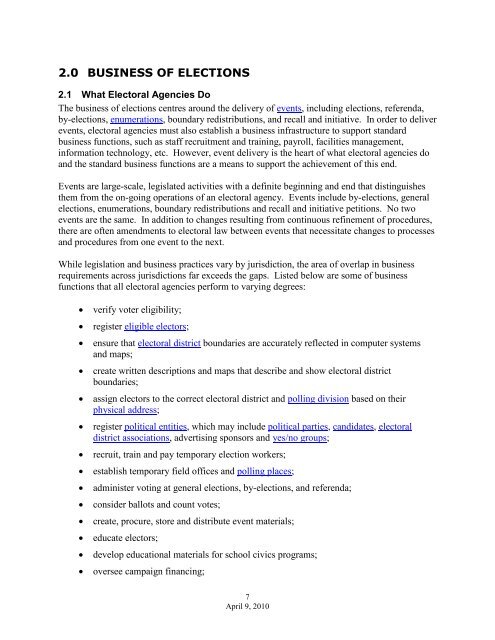Electoral-Management-Reference-Model-v.1.0
Electoral-Management-Reference-Model-v.1.0
Electoral-Management-Reference-Model-v.1.0
Create successful ePaper yourself
Turn your PDF publications into a flip-book with our unique Google optimized e-Paper software.
2.0 BUSINESS OF ELECTIONS<br />
2.1 What <strong>Electoral</strong> Agencies Do<br />
The business of elections centres around the delivery of events, including elections, referenda,<br />
by-elections, enumerations, boundary redistributions, and recall and initiative. In order to deliver<br />
events, electoral agencies must also establish a business infrastructure to support standard<br />
business functions, such as staff recruitment and training, payroll, facilities management,<br />
information technology, etc. However, event delivery is the heart of what electoral agencies do<br />
and the standard business functions are a means to support the achievement of this end.<br />
Events are large-scale, legislated activities with a definite beginning and end that distinguishes<br />
them from the on-going operations of an electoral agency. Events include by-elections, general<br />
elections, enumerations, boundary redistributions and recall and initiative petitions. No two<br />
events are the same. In addition to changes resulting from continuous refinement of procedures,<br />
there are often amendments to electoral law between events that necessitate changes to processes<br />
and procedures from one event to the next.<br />
While legislation and business practices vary by jurisdiction, the area of overlap in business<br />
requirements across jurisdictions far exceeds the gaps. Listed below are some of business<br />
functions that all electoral agencies perform to varying degrees:<br />
• verify voter eligibility;<br />
• register eligible electors;<br />
• ensure that electoral district boundaries are accurately reflected in computer systems<br />
and maps;<br />
• create written descriptions and maps that describe and show electoral district<br />
boundaries;<br />
• assign electors to the correct electoral district and polling division based on their<br />
physical address;<br />
• register political entities, which may include political parties, candidates, electoral<br />
district associations, advertising sponsors and yes/no groups;<br />
• recruit, train and pay temporary election workers;<br />
• establish temporary field offices and polling places;<br />
• administer voting at general elections, by-elections, and referenda;<br />
• consider ballots and count votes;<br />
• create, procure, store and distribute event materials;<br />
• educate electors;<br />
• develop educational materials for school civics programs;<br />
• oversee campaign financing;<br />
7<br />
April 9, 2010


